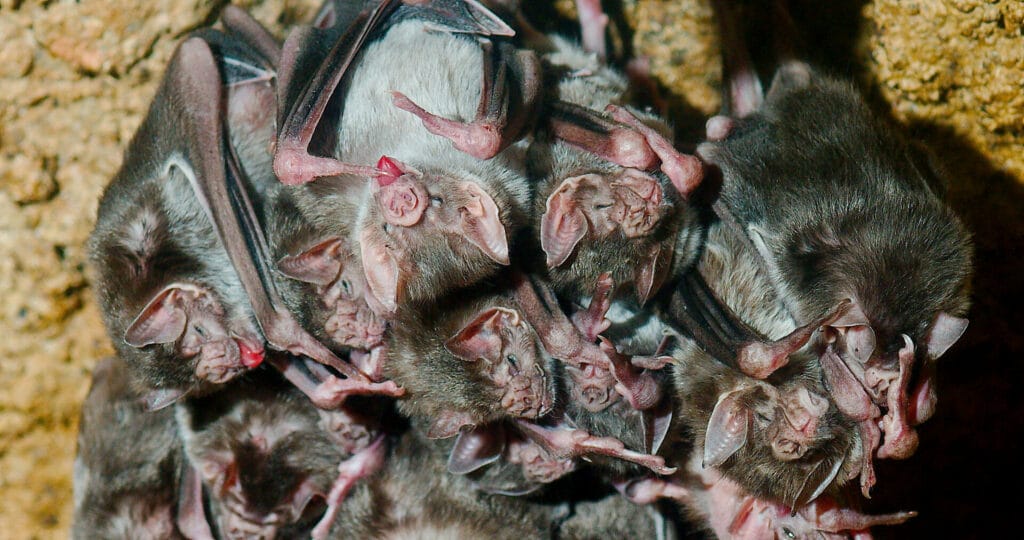As self-spreading vaccine technology moves forward, dialogue on its risks should follow
By Jonas Sandbrink | June 10, 2022

Scientists in Scotland recently penned the latest installment in the literature about the quest for self-spreading vaccines, inoculations that could move through animal populations like a disease, but instead of illness, spread immunity. In a new article, University of Glasgow researcher Megan Griffiths and her colleagues identified a herpes virus that might be turned into a vehicle known as a viral vector to spread a rabies vaccine among South American vampire bats. The herpes virus Griffiths highlighted could potentially help researchers overcome a big hurdle for self-spreading vaccine development: Pre-existing immunity to a viral vector used for a vaccine, induced by previous infection with the virus or a related strain, may block the vaccine from spreading. Griffiths’s team studied a herpes virus that can infect bats even if they were previously infected by related strains and therefore could still be an effective viral vector.
It’s a development that Scott Nuismer, a biologist and leading figure in self-spreading vaccine research, said “moved us closer to the point where these challenges” in deploying a vaccine can be solved. But self-spreading vaccine technology is inherently risky. Once let loose, the vaccine could recombine with human pathogens. Also, it could help malicious actors create viruses capable of causing pandemics. Despite these risks, self-spreading vaccine research appears to be moving forward. Behind the scenes, however, a promising trend is emerging: In journal articles, biosecurity experts and other scientists in the field are grappling with each other’s ideas and potentially paving the way for discussions that could offer a roadmap for mitigating risks from emerging biotechnologies.
Benefits and risks of self-spreading vaccines. The story of self-spreading vaccines began more than 20 years ago with the study of a vaccine for rabbit haemorrhagic disease that spread from initially inoculated animals to other rabbits, imparting immunity to a large share of the rabbit herd. Until recently, however, few in the media and the general public paid attention to the niche area of study. This changed when, at the height of the first COVID-19 peak, Nuismer and biologist James Bull published an article in the journal Nature Ecology & Evolution. The piece precipitated a raft of media coverage of self-spreading vaccines and sparked expressions of concern from biosecurity experts.
In a primer accompanying Griffiths’s new study, Nuismer (who wasn’t part of the University of Glasgow research) highlighted the most direct potential application of self-spreading vaccines: reducing the risk of human infections with animal pathogens. Self-spreading vaccines could provide a cost-effective way to vaccinate animal populations and reduce the incidence of pathogens capable of infecting humans, in contrast to resource intensive wildlife vaccination drives. Cost-effective animal vaccination could also be used for wildlife conservation and, according to proponents, may even allow the preemptive elimination of pathogens capable of causing pandemics—even if the feasibility of the latter is highly uncertain.
On the other hand, critics have highlighted that the release of a self-spreading virus may have unanticipated and potentially harmful consequences. In their most commonly advocated form, self-spreading vaccines are based on the insertion of a non-pathogenic genetic element of the vaccine target, say the rabies virus, into a transmissible but generally harmless virus. Like traditional inoculations, the self-spreading vaccine could prime a recipient’s immune system to recognize and fight harmful pathogens.
It is most likely that a self-spreading vaccine will turn back into a harmless virus, as the foreign genetic element (in the case of a rabies vaccine, a non-pathogenic part of rabies virus) is evolutionarily burdensome to the viral vector. Nevertheless, a self-spreading vaccine virus could transfer the foreign genetic element or other genetic modifications to other viruses, including human ones. Such genetic recombination may have unexpected consequences many years later and across borders. A recombined version of a virus released in 1952 for rabbit pest control in France was recently found to kill wild hares in Spain.
Dangerous insights on viral engineering. History shows the risk that a malicious group would use a biological agent as a weapon isn’t just a hypothetical concern. In the 1990s, the Japanese doomsday cult Aum Shinrikyo sought to engineer biological weapons and almost succeeded. Similar groups gaining access to modern synthetic biology is a source of grave concern—especially the capability to engineer transmissible pathogens capable of causing a pandemic.
As the point of self-spreading vaccines is to transmit autonomously, it seems likely that researchers will be tempted to manipulate the transmissibility of their vaccine viruses. If research on engineering viral transmissibility were successful, the result could be increased capabilities to create pandemic-capable viruses and lowered barriers to their misuse.
Importantly, a focus on optimizing only non-pathogenic vaccine viruses does not protect against the possibility that others might misuse these optimized capabilities. Insights on transmissibility and other genetic modifications may be generalizable and transferable to more pathogenic viruses: The historical biological weapons program of the Soviet Union studied genetic modifications in a related non-pathogenic virus for eventual transfer to the deadly virus that causes smallpox. The frightening bottom line: Scientists optimizing self-spreading vaccines may inadvertently recreate efforts to develop biological weapons.
Research into fine-tuning viral transmissibility, while a particularly concerning case, is only one instance of an accelerating flood of transferable insights applicable to the enhancement of pathogens. The source of these transferable insights are efforts to engineer viruses for an increasing range of therapeutic applications. These include not just vaccine development but also gene and cancer therapy. For instance, cancer researchers are engineering viruses to target specific parts of the body and modulating interactions with the immune system. These fields have not classically featured consideration of dual-use risks, and researchers and funding bodies are frequently not aware of the misuse potential of their work.
This unawareness is troubling as platform approaches and general-purpose methods from these areas of science increasingly drive viral engineering capabilities.
An opportunity for actionable progress. In 1975, leading experts came together at the Asilomar Conference to lay the path for the safe and ethical use of genetic engineering. The resulting guidelines have had long-lasting effects on the field. A recent twist of the self-spreading vaccine saga provides an opportunity for similar multi-disciplinary discussions on safety and ethics. In March, concerned biosecurity experts and advocates came head-to-head in dueling pieces in the journal Science over the regulation of self-spreading vaccines. Advocates and concerned experts have stepped forward, articulated the benefits and risks of self-spreading vaccines, and engaged with each other in writing. Now, there is momentum for actionable progress which could be realized through in-person discussions.
A goal that unifies both advocates and critics should lie at the heart of such discussion: mitigating disease and improving health outcomes. Outside of contributing to this goal, the development of self-spreading vaccines does not feature intrinsic value. For a given challenge of mitigating disease, different solutions with associated benefits and risks need to be compared. For instance, to reduce the recurring spillover of rabies, vaccines transferred through animal behavior, such as a vaccine paste that inoculates bats as they groom one another, feature most of the benefits of self-spreading vaccines but comparatively little risk. For preventing future pandemics, self-spreading vaccines need to be compared against investments in healthcare systems, fast response vaccine platforms, or the detection of pathogen spillover at the animal-human interface. Where funding bodies and researchers are exploring self-spreading vaccines, comparative risk-benefit assessment could guide decisions on what virus to base the vaccine on and what engineering approaches to explore. For instance, a strong commitment by self-spreading vaccine researchers to never optimize transmissibility could significantly cut risks while retaining the vast majority of benefits.
In a time where risks are associated with an ever-greater fraction of life sciences research, the crucial point for considering risks is not after a project has been funded but before. In the absence of clear benefits of one project over another, the lowest risk avenue should be pursued. For instance, certain viral engineering approaches feature less risks of being transferable to pathogens and should be explored preferentially for vaccines or cancer therapy. Comparative risk-benefit assessment can mitigate the misuse potential of our research portfolio without sacrificing benefits.
A productive discussion of self-spreading vaccines would be an important step on the road to addressing one of the greatest challenges of the coming decades: how to manage the proliferation of the ability to create pandemic viruses.
Together, we make the world safer.
The Bulletin elevates expert voices above the noise. But as an independent nonprofit organization, our operations depend on the support of readers like you. Help us continue to deliver quality journalism that holds leaders accountable. Your support of our work at any level is important. In return, we promise our coverage will be understandable, influential, vigilant, solution-oriented, and fair-minded. Together we can make a difference.
Keywords: self-spreading vaccines
Topics: Biosecurity, Opinion















